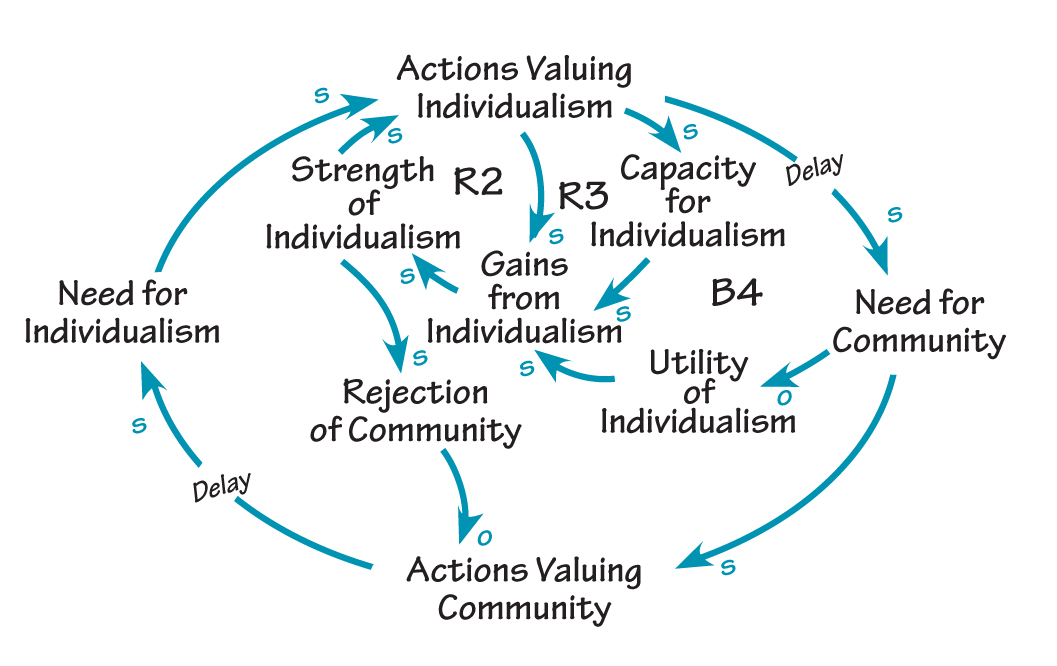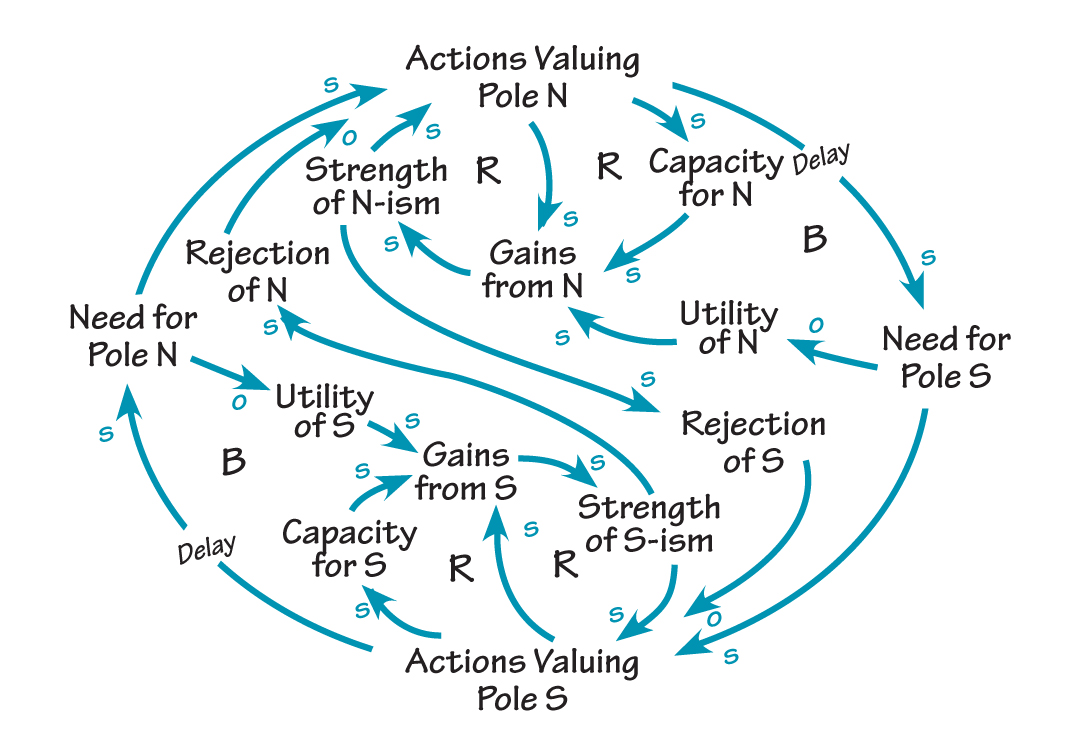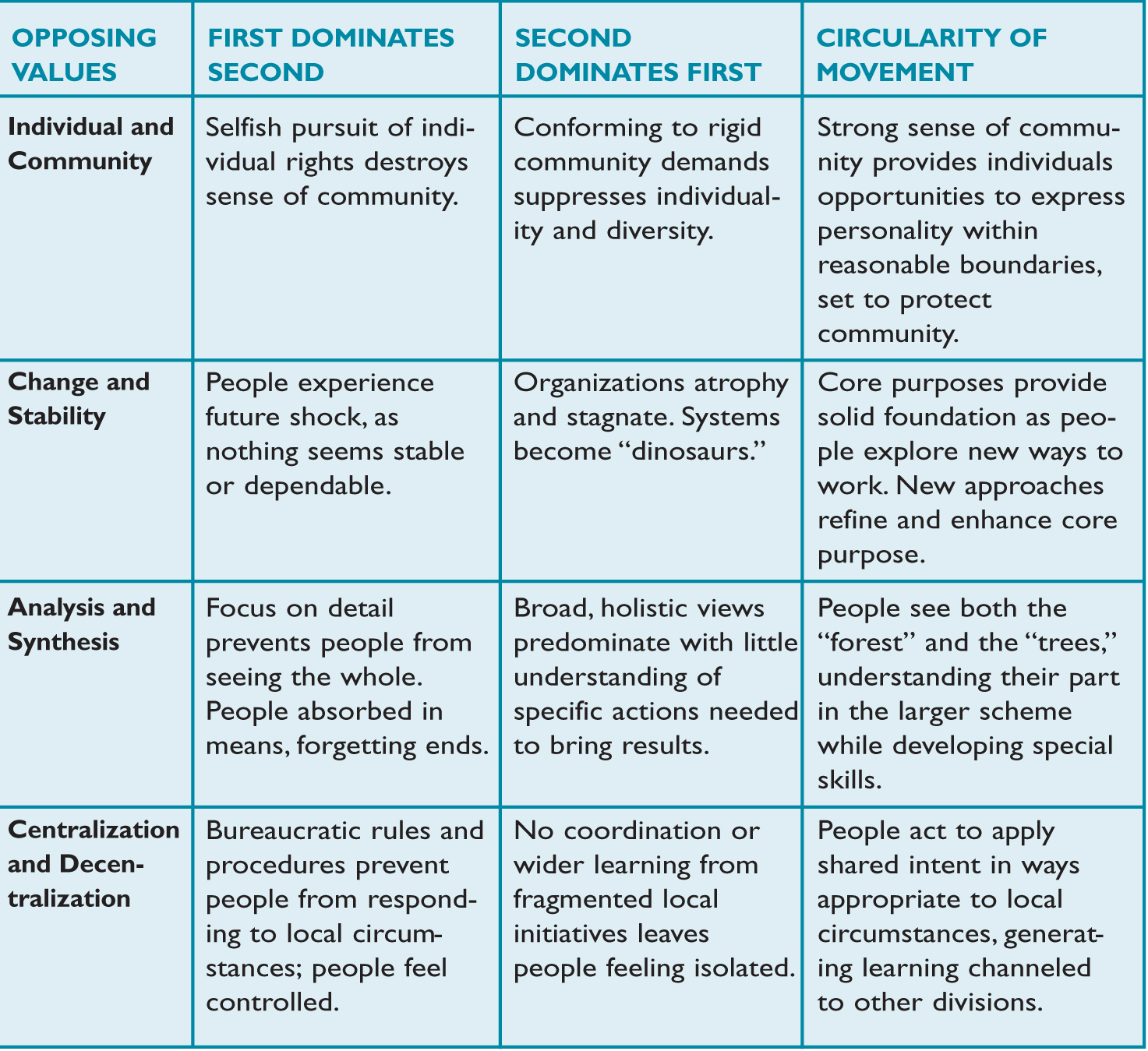When faced with a problem, how often do teams within your organization become polarized around proposed solutions that are opposites? For example, one group of people may be convinced that the only way to increase productivity is through greater teamwork, while another group may advocate better management of individuals as the best method for bringing about the desired result. Or perhaps the impasse exists over whether decision-making within the organization should be more centralized or more decentralized.
We regularly find ourselves stuck in futile conflicts over the choices we face. How can intelligent, committed people in the same organization be so divided? Could it be that both sides are right? If so, how does the conflict come about? And how can you and your team leverage the differences that exist among you? Help lies in understanding the structure of paradox.
Managing Paradox
In their study of organizational effectiveness, James Collins and Jerry Porras noted that a distinguishing characteristic of highly visionary companies is the capacity to manage paradox. These authors define such capacity as “the ability to embrace both extremes of a number of dimensions at the same time” (Built to Last, p. 44). This rare capability seems to allow successful companies to avoid falling into a pattern of values-based conflict, with parties becoming increasingly polarized around “either/or” choices.
Many decisions that groups face involve a choice between opposing values. Thus, when resolving a dispute, a team may feel the need to choose between the rights of an individual member and the well-being of the group as a whole.
Because the two choices are opposites, the group will take actions that support one value rather than the other. For example, in an emergency, people within a group may be expected either to “pitch in” and take actions that help the group as a whole, leaving aside their personal objectives for a time, or to complete their personal objectives first and help the team if they have spare time. Group norms and organizational reward systems tend to encourage one approach over the other.
In many cases, though, the values are interdependent. Over time, an organization requires both values to be healthy (Barry Johnson, Polarity Management). Thus, when any group is formed, a cycle begins between opposing values (see “Circularity of Values”). Initially, the team feels a strong need for one value, such as individualism. Team members then take actions that value individualism. If unchecked, however, individualism destroys the cohesiveness of the group. So, individualistic actions eventually create a need for actions that value community. Over the long run, this focus on community will in turn create a need for individualism, as group members lose their sense of personal identity. Some investigators of organizational culture refer to this movement between opposites as the “circularity of values“ (Hampden-Turner and Trompenaars, The Seven Cultures of Capitalism).
For example, Performance Management Associates (PMA), a small consulting company founded by Ralph and Sarah, had experienced consistently high demand for its services. Ralph was known for introducing leading-edge management concepts to organizations in need of change. He continually sought new ideas and built them into his consulting work. Ralph’s clients found his approach innovative and challenging.
Sarah, on the other hand, had long recognized that Ralph’s ideas were of limited value for businesses unless they could be further developed into systems and training products. By framing Ralph’s insights in ways that organizations could implement and use, Sarah helped clients institutionalize needed changes. She brought stability and quality control to PMA.
Encouraged by their company’s success, Ralph and Sarah hired two new consultants. With the support the additional staff would provide, Ralph planned to increase the pace of his innovative work, Barry and Frank, the newcomers, were excited by the prospect of further developing Ralph’s ideas.
CIRCULARITY OF VALUES

In this reinforcing loop, healthy circularity operates, as actions supporting one value create a need for its opposite.
However, at PMA, Barry and Frank felt they were approaching clients with half-formed products. Worse, Ralph kept coming up with new ideas even though the old ones still weren’t fully developed. Barry and Frank grew frustrated with their work. When they complained that life at PMA had gotten too chaotic, Ralph felt they didn’t understand the principles on which he and Sarah had built the business.
Thus, after years of success, PMA reached a state of crisis. The new consultants threatened to leave the organization. And several clients voiced their concern about the errors that sometimes crept into PMA’s administrative practices.
The introduction of new people at PMA disrupted what had been a healthy movement between the opposing values of innovation and product quality. At the same time, Ralph’s increased focus on innovation ultimately became detrimental to the organization as a whole. As we will see, PMA needed to learn how to manage opposing values, or paradox, in this new configuration.
Unconscious Assumptions
The movement between two opposites rarely happens smoothly. Often, the delay between actions that support one value and the growth in the need for its opposite leads to an unconscious overemphasis on the original value. For instance, when a group clearly sees a gain from actions valuing the individual, it tends to resolve subsequent dilemmas in favor of the individual. Over time, the team will find that it emphasizes individualism without consciously thinking about the alternative. In this way, the group creates an unconscious assumption that pursuing one value ahead of its opposite is the best way to act. Thus, individualism may become part of the group’s culture—its unconscious assumptions regarding the best way to act. This is represented in “Over-reliance on One Value” as the variable “Strength of Individualism,” which grows as a result of loop R2.
Another factor that causes imbalance between opposing values is that, as group members act in support of a value, they build their capacity to support that value (R3). An organization that has a history of valuing individualism is likely to have built up systems and skills that support individualism.
PMA was experiencing similar dynamics based on the values of “innovation” and “quality”: The company could invest in finding new products or in improving the quality of existing ones. Ralph found that his efforts to introduce innovative products brought gains in the form of satisfied customers. His capacity for generating further innovations also grew. Not surprisingly, his assumption about the benefits of innovation became embedded in PMA’s culture. This dynamic explains why Ralph, and PMA, pushed for more and more innovation in their work, despite the problems this created.
Finally, as mentioned earlier, “Actions Valuing Individualism” will eventually lead to a need for “Actions Valuing Community.” As the need to value community grows, the “Utility of Individualism” and the group’s gains from its actions valuing individualism also fall (B4). B4 thus acts as a limit to the growth that comes from the reinforcing processes in R2 and R3.
Conflicting Cultures
As at PMA, most organizations include groups with opposing values. Some focus on the gains to be made by sticking with the values that have brought them success in the past. Barry Johnson refers to such groups as “tradition-bearers.” As the need for the opposite value grows, other members of the organization act as “crusaders” for new values.
Tradition-bearers and crusaders within organizations conflict over values. As the strength of each group’s culture develops, so does the belief that the other’s values are wrong. At PMA, Ralph’s ever-growing belief in the value of innovation led him to reject calls for greater stability.
OVERRELIANCE ON ONE VALUE

So far, the description of interdependent opposites has focused on the behavior of those in the organization holding the primary value (individualism in the diagram, or innovation in PMA’s case). Within most organizations, these dynamics will be mirrored by those holding the opposing value. It is easy for any group to look past the interdependence of the values that are in conflict. An organization has experienced gains based on its values and has made a commitment to those values by developing capacity around them. We often feel that if one value is good, its opposite must be bad (De Bono, I Am Right, You Are Wrong).
In addition, any group can readily find examples of the misuse of the opposing value. A value is misused when people continue to apply it past the point where it starts to undermine its opposite. Thus, extreme individualism destroys a group’s sense of community. Concern for community, taken too far, erodes individual freedom and opportunity.
This pattern allows people holding one value to categorize all those holding the opposite value as extremists who want to take the rejected value too far. So, for example, people who value individualism may label those with values that focus on community as “communists.” People who value community may label those with individualistic values as “anarchists.”
At PMA, Ralph could point to numerous examples of clients who suffered from their reluctance to adopt new ideas, and these cases intensified his reliance on innovation. Frank and Barry, on the other hand, saw plenty of clients who were unable to institutionalize change based on their work with PMA. In their view, these examples confirmed the need for higher levels of product quality at PMA.
Leverage
The circularity of values is a naturally occurring cycle in living systems; for instance, there is constant movement between inhaling and exhaling, exertion and relaxation, integration and differentiation. Healthy movement between these opposites is needed to sustain the system. Problems arise because of the unconscious over-reliance on one value at the expense of another. Conflict between groups within an organization is usually a tip-off that this unconscious process has begun.
Many people assume that solutions to problems caused by values-based conflict must involve power. Those crusading for a change in organizational practices feel that they should have more power in order to exert a greater influence. Tradition-bearers use the power they have to hold on to what they value. However, power-based strategies address only the symptoms of the structure of interdependent opposites; they resolve conflict by allowing one group to “win.” In the future, either the conflict will return because the need for the “losing” value remains, or the system will die. To expose the self-destructive nature of this power-based approach, Johnson encourages people to imagine the effect of treating breathing (inhaling and exhaling) as a conflict and having one side “win” at the expense of the other.
VALUES-BASED CONFLICT

The back-and-forth dynamics within the structure tend to draw participants’ attention away from the healthy operation represented by the outside loop (see “Values-Based Conflict“). To gain leverage, participants need to become aware of the possibilities that emerge when the outside reinforcing loop is working well. Those functioning within the system should also become conscious of the interdependence of the opposing values. Dialogue can be a useful tool for surfacing the need for a circularity of movement between values.
People must be willing to move away from what they value in order to bring about the vision they desire—while trusting that the organization will eventually come back around the loop. They do not have to give up what they believe; they just have to live with a delay before their beliefs take center stage again. According to Robert Fritz, without awareness of this cycle, groups may oscillate between values rather than applying those most likely to bring about the greatest gains and highest leverage.
In Polarity Management, Johnson describes a simple yet powerful approach to attaining this leverage. His method involves charting both the upside and downside of each of the opposing values. This allows people to see and feel the need for movement between the values, determine the direction of movement currently needed, and establish how they will recognize the need to change emphasis. This approach is one way to achieve what Hampden-Turner describes as “reconciliation of values.”
At PMA, Sarah recognized the need to stop the values-based conflict. Her solution was to split the company into two divisions. At one division, Barry, Frank, and Sarah concentrate on customizing and running existing programs for clients, and on improving the quality of PMA’s services. At a separate location, Ralph develops new products. Once he develops a product, he passes it on to the other group, so that he can move on to new ideas.
The new structure allows everyone at PMA to appreciate all the values contained within the company. Ralph now sees the need for quality. Barry and Frank are increasingly innovative in their own work, building on a foundation of solid products. They often consult Ralph about ways to improve their practice. The reconciliation of values at PMA has had a beneficial impact on the company’s work with clients as well. Because client organizations also require this movement between innovation and quality, the company can offer them consulting services at whichever stage of the cycle the clients find themselves. As members of one division of PMA see their clients’ gains diminishing, they might refer them to the other division.
Interdependent Opposites and Organizational Learning
Research by Hampden-Turner and Trompenaars suggests that English speaking democracies (such as the U.S., U.K., Canada, Australia, and New Zealand) are characterized by:
- putting universal rules ahead of relationships
- putting individual rights ahead of community health
- dealing with complexity analytically as opposed to integratively
- awarding status on the basis of achievement rather than ascribing status on some other basis (for example, age or experience)
Each of these pairings follows the dynamics illustrated in “Values-Based Conflict”; for example, Universal Rules could be featured at the top of the diagram, with Relationships featured at the bottom. Because many groups and organizations in the West follow the pattern of valuing rules, individualism, analysis, and achievement, we could group all four of these values at the top and call them “Cluster A,” and then group relationships, community values, integration, and ascription at the bottom and call them “Cluster B.”
Organizational cultures within English-speaking democracies tend to overemphasize the Cluster A values. We can view the disciplines of organizational learning as a movement designed to compensate for this over-reliance. So, for instance, team learning emphasizes relationships and community ahead of managing or controlling individuals through the use of universal rules. Systems thinking encourages integrative thinking over analysis. Learning organizations may award status to members of the organizational community who share the community’s vision, rather than to those who achieve success according to analytically derived performance indicators.
Organizational learning practitioners thus take on the role of crusaders for values opposite to those unconsciously held by many in their organizations. Yet this crusading inevitably generates conflict with tradition-bearers. To support their crusade, practitioners may inadvertently enter into low-leverage, power-based strategies. They would do better to make the circularity of the values in contention visible to all, using the techniques described above.
Reconciliation
All groups face challenges involving opposing values. Indeed, the very nature of values and the structure of paradox lend themselves to conflict. Groups too easily see the benefit to be gained from their own values and a danger in pursuing values held by others.
The structure of paradox also encourages groups to pursue their traditional values until they experience crisis. But by definition, a crisis cannot be resolved by relying on the assumptions that originally got the organization into the situation (Mitroff et al., Framebreak). As we have seen, overemphasis on one value requires a shift to its opposite to undo harm that has been done. “Managing Opposing Values” provides examples of the results of either managing or mismanaging common pairs of opposing values. Only when these are managed well can an organization sustain itself over time.
Most diverse, complex organizations already possess the values required for building a sustained future. The challenge groups face is to reconcile these differing values—the same values that often generate the most heated conflict within the organization. Rather than experiencing differences in values as a struggle that immobilizes an organization, people should enjoy these differences as diversity that infuses the organization with vigor and variety.
Philip Ramsey is a lecturer in Training and Development and Organizational Learning at Massey University in New Zealand. He is the author of the Billlbonk series, a set of stories that teach systems thinking and organizational learning concepts.
MANAGING OPPOSING VALUES

